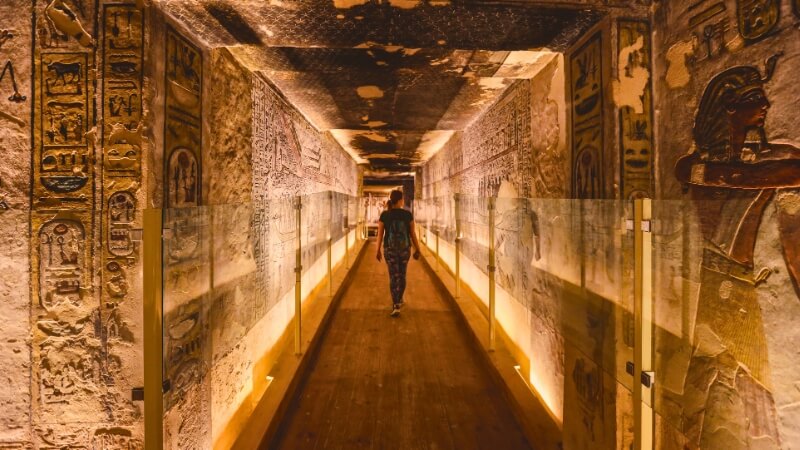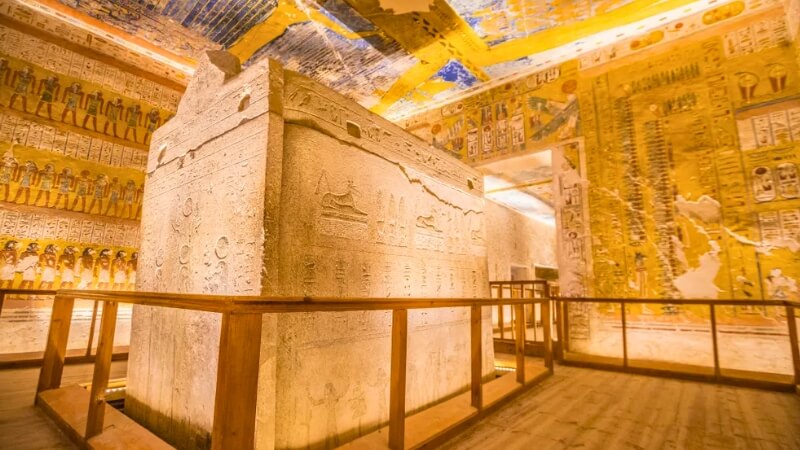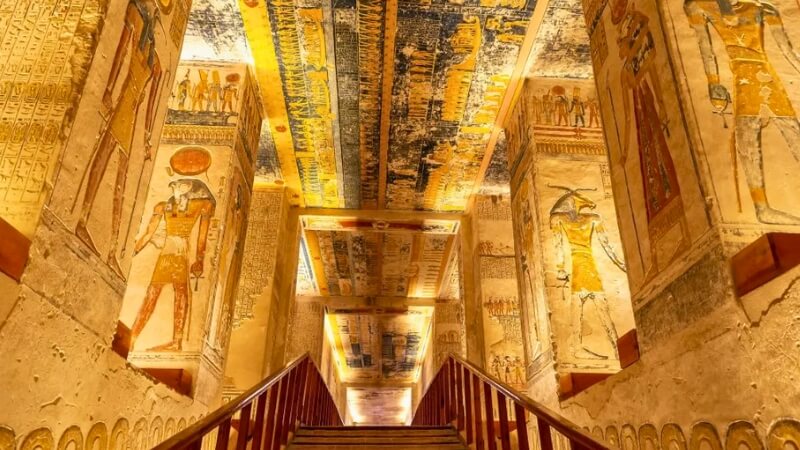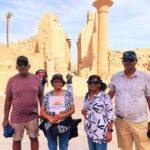Are you into ancient history? If yes, Luxor‘s Valley of the Kings is a must-see. It’s where pharaohs and nobles of the New Kingdom rest.
Being a UNESCO World Heritage site, it shows Egypt’s deep history. You’ll see detailed tombs and ancient artifacts. Visiting ancient Egyptian tombs is a unique chance to see history come alive.
The Valley of the Kings: Egypt’s Royal Burial Ground
The Valley of the Kings is on the west bank of the Nile. It has over 60 tombs, including Tutankhamun’s. It’s a key historical landmark for those visiting Egypt.
In Luxor, Egypt, the Valley of the Kings is a huge necropolis. It was where many pharaohs were buried. It shows the detailed funerary practices and beliefs of ancient Egyptians.
The Valley of the Kings is full of intricate tombs. Each one tells a story of the pharaohs buried there. It’s a UNESCO World Heritage site, showing its cultural and historical value.
Travelers should not miss the Valley of the Kings on their Egypt travel plans. It gives a peek into ancient Egypt’s history and burial customs. With its many tombs and importance, it’s a top historical landmark in Egypt.
Historical Evolution of the Royal Necropolis
When you enter the Valley of the Kings, you step into a world of history. It started as a burial ground for Thutmose I (1525-1504 BCE). Since then, it has been the main place for Egypt’s pharaohs to be buried.
The Valley of the Kings is more than tombs. It’s an archaeological site that shows ancient Egypt’s burial customs. It also reveals the rituals to help pharaohs reach the afterlife. Over time, each pharaoh added their own story to this site.
The Early Years
The site was picked for its hidden spot and natural shape, seen as a path to the afterlife. The first tomb, KV 38, was for Thutmose I. It set the standard for future tombs.
As the New Kingdom grew, so did the tombs’ size and beauty. Leaders like Hatshepsut and Thutmose III built impressive tombs. These showed Egypt’s wealth and power.
Peak and Decline
The Valley of the Kings was at its best under Ramses II. His tombs were grand, showing his status. But, as Egypt’s power faded, so did the Valley’s use for royal burials.
Even in decline, the Valley of the Kings is a treasure trove of history. It gives us a glimpse into the lives and deaths of Egypt’s pharaohs. The tombs of pharaohs here show the ancient Egyptians’ engineering and art skills.
Today, visiting the Valley is like uncovering history. You’re learning about ancient Egypt’s most influential rulers.

10 Most Spectacular Tombs You Must See
Exploring the Valley of the Kings reveals many impressive tombs. Over 60 tombs showcase different histories and styles. Here are the top 10 tombs you shouldn’t miss.
Tutankhamun’s Tomb (KV62) – This is the most famous tomb in the Valley of the Kings.
The Discovery That Changed Egyptology
Howard Carter’s discovery of Tutankhamun’s tomb in 1922 was a big deal. It gave us new insights into ancient Egyptian burial practices.
Ramses VI’s Tomb (KV9) – This tomb is known for its well-preserved paintings and detailed reliefs. It’s one of the best tombs to visit in the Valley of the Kings.
What You’ll See Inside
Inside Ramses VI’s tomb, you’ll see ancient Egyptian gods and goddesses. You’ll also see scenes from the Book of the Dead.
Seti I’s Tomb (KV17) – Many call this one of the most beautiful tombs in the Valley of the Kings. It has stunning reliefs and paintings.
The remaining 7 tombs to complete your list of the top 10 tombs to visit include: – Horemheb’s Tomb (KV57) – Ay’s Tomb (KV23) – Merenptah’s Tomb (KV8) – Siptah’s Tomb (KV47) – Tausret’s Tomb (KV14) – Ramses III’s Tomb (KV11) – Thutmose III’s Tomb (KV34)
Each of these tombs gives a unique look into ancient Egypt’s funerary practices. They are archaeological marvels that you shouldn’t miss on your Valley of the Kings tours.
When planning your visit, check the opening hours and ticket needs for each tomb. Some may have limited access.
Artistic Treasures and Architectural Marvels
Exploring the Valley of the Kings reveals a world of ancient Egyptian art and architecture. The tombs here are famous for their detailed artwork and hieroglyphics. These show us what life was like for ancient Egyptians.
The walls of the tombs are filled with pictures of gods and goddesses. They also show scenes from the Book of the Dead. These archaeological treasures show the ancient Egyptians’ skill in art. They also give us clues about their burial customs.
The Valley of the Kings is known for its impressive tomb architecture. Building these tombs took a lot of skill and hard work. They show how important the pharaohs were.
The Valley of the Kings is a key spot for those interested in ancient Egypt. As you see the tombs, you’ll find a lot of ancient Egyptian art. This includes detailed hieroglyphics and beautiful stone carvings.
The tombs are also amazing feats of engineering. The complex tunnels and chambers show the ancient Egyptians’ cleverness. They built these sites with great precision.
As you keep exploring, you’ll find many archaeological treasures. The Valley of the Kings is a special place. It offers a memorable experience for those who love history, art, and architecture.
5 Groundbreaking Discoveries That Shaped Our Understanding
The Valley of the Kings has made many surprising finds. These discoveries have changed how we see ancient Egypt. The finding of Tutankhamun’s tomb by Howard Carter in 1922 was a big moment. It showed us a lot about the pharaohs’ burial rites. The Tomb of Tutankhamun
This discovery made people all over the world interested in ancient Egypt. It also gave archaeologists a chance to learn about the New Kingdom period. The golden mask of Tutankhamun is now a famous symbol of ancient Egypt.
Another key find is the tomb of Ramses VI. Its decorations tell us a lot about ancient Egypt’s myths and funerals. The tomb’s design and art help us see how burial practices changed over time.
The Valley of the Kings has also taught us about the pharaohs buried there. For example, KV55 is thought to be Akhenaten’s tomb. This discovery has given us a better understanding of this mysterious pharaoh.
Recently, new technologies like ground-penetrating radar have found new tombs. They have also looked at old ones again. These new tools have greatly improved our knowledge of the Valley of the Kings and its pharaohs.
When you visit the Valley of the Kings, you’ll see how these discoveries are important. They have greatly changed our view of this exciting time in history. The Valley of the Kings is still a key site for archaeology. Ongoing digs and studies are giving us new insights into the pharaohs and their burial customs.

Fun Facts about the Valley of the Kings Egypt facts
Over 60 Tombs: Though the Valley is famous for its royal tombs, it also contains burials of high-ranking officials and workers.
Not Just Pharaohs: Some of the tombs belong to prominent individuals who were not pharaohs but still held significant status.
Curse of the Pharaohs: After Tutankhamun’s tomb was opened, a “curse” was rumored to plague those involved, adding a layer of mystery and allure to the Valley.
Secrets Still Uncovered: Archaeologists continue to search for more tombs and treasures. Valley of the Kings Egypt facts, may still hide secrets waiting to be unearthed.
Planning Your Visit: Essential Information
Getting ready for your trip to the Valley of the Kings? It’s key to know the basics. This site is a big hit for Egyptian tourism, drawing many visitors yearly. To enjoy your Valley of the Kings tours fully, understanding the basics is a must.
The Valley of the Kings is open every day. But, the hours change with the seasons. In winter, it’s open from 6:00 AM to 5:00 PM. In summer, it stays open till 6:00 PM. Knowing this helps plan your day, avoiding the hottest sun hours.
Think about ticket prices when planning your visit. Admission costs can change, so check the latest prices before you go. Also, some tombs might need a special ticket. So, plan your Luxor attractions carefully.
If you’re traveling from far away, Egypt travel needs some prep. Make sure you have the right visas, shots, and travel papers. Also, knowing local customs and dress codes will make your visit better and show respect for the culture.
Arrive early to beat the crowds and heat. Wear comfy shoes and clothes for walking. Don’t forget to stay hydrated and protect yourself from the sun.
Being well-informed and prepared makes your Valley of the Kings visit better. This ancient site is a must-see for history buffs, archaeology fans, or anyone wanting to see Egypt’s wonders.
7 Practical Tips for an Unforgettable Experience
To make the most of your visit to the Valley of the Kings, consider these seven essential tips. They will enhance your exploration of this ancient Egyptian burial site.
- Wear Comfortable Shoes: The Valley of the Kings is a vast archaeological site. You’ll likely do a lot of walking. Wearing comfortable shoes will make a significant difference in your overall experience.
- Stay Hydrated: Bring plenty of water to stay hydrated, specially during the hot summer months. The dry climate can quickly lead to dehydration if you’re not careful.
- Protect Yourself from the Sun: Sun protection is crucial. Bring a hat, sunglasses, and sunscreen to shield yourself from the harsh sun.
- Plan Your Visit According to the Season: The best time to visit is during the cooler months from October to February. Avoid visiting during the peak summer months if possible.
- Respect the Site: Remember that the Valley of the Kings is not just a tourist attraction but also a historical and sacred site. Be respectful of the tombs and other archaeological features.
- Consider a Guided Tour: A guided tour can provide valuable insights into the history and significance of the tombs. Enhancing your overall experience.
- Capture Memories Wisely: While it’s tempting to take photos, be mindful of any restrictions on photography within the tombs. Focus on capturing memories that won’t damage the site or disturb other visitors.
By following these tips, you’ll be well-prepared for an unforgettable experience at the Valley of the Kings. It’s one of the world’s most fascinating historical landmarks.

Beyond the Valley: 5 Related Sites to Complete Your Journey
- Luxor is full of historical landmarks. There’s more to see than just the Valley of the Kings. Plan to visit these five sites to learn more about ancient Luxor.
- Karnak Temple is huge and a top spot in Luxor. It’s famous for its huge hall and detailed hieroglyphics. It shows how ancient Egyptians worshipped.
- The Luxor Temple is another key site. Built around 1400 BCE, it’s known for its architecture. It tells stories of ancient Egyptian culture and worship.
- The Tombs of the Nobles are also a must-see. They’re on the west bank of the Nile. They give a peek into the lives of ancient Egypt’s nobility.
- Deir el-Medina is the village of the artisans. It shows what daily life was like for workers and their families. It offers a personal view of ancient Egyptian society.
- Don’t miss Madinat Habu, a temple for Ramses III. It’s famous for its architecture and history. It’s a great addition to your Luxor trip.
- These sites, along with the Valley of the Kings, make a complete tour of Luxor. They ensure your trip is unforgettable and enlightening.
Conclusion: The Enduring Legacy of the Valley of the Kings
The Valley of the Kings shows the rich history and culture of ancient Egypt. It is where pharaohs were laid to rest and holds many archaeological treasures.
Visiting the ancient Egyptian tombs and the pharaohs’ burial site helps us understand its importance. The Valley of the Kings fascinates people worldwide. It gives us a peek into the lives and customs of ancient Egypt’s rulers.
The treasures found in the Valley of the Kings have helped us learn more about ancient Egyptian history and culture. This makes it a key place for those who love history, archaeology, or culture.




